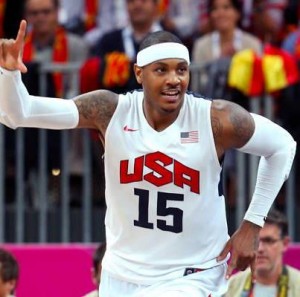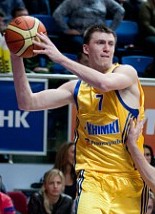 So we’re all getting a reminder of how things are really day-to-day in the Olympics, eh?
So we’re all getting a reminder of how things are really day-to-day in the Olympics, eh?
A couple days ago, Carmelo Anthony had the new U.S. Olympics scoring record (37) and Team USA was considered unbeatable after they out Dream Teamed the original Dream Team and beat Nigeria by 83.
Then we get through Day 4 of the competition, and the world has turned upside down. The single highest-scoring game now belongs to Patty Mills of Australia, who dropped 39 on Great Britain as the Boomers came back from an 10-point halftime deficit to defeat Great Britain.
Oh, and Team USA?
Not looking quite so unbeatable anymore, I’d say. When those 3-pointers don’t fall, when the defense gets its share of turnovers but can’t get stops at other times, when the rim is unprotected with Tyson Chandler (8 minutes vs. Lithuania) on the bench, the U.S. team is a structurally flawed team. There’s no getting around that fact.
One week from today, we’ll have our gold medal game.
And right now, it looks like Team USA will go up against Australia in the quarterfinals, Argentina, Spain or Brazil in the semifinals, and Russia, France, Spain or Brazil in the gold medal game (assuming they get there).
But the unexpected can happen, and Monday could be the day the tanks roll in and change everything.
So …
Before Monday’s games get underway, let’s ask 5 pertinent questions about the 2012 Olympics:
1. IS IT A CERTAINTY THAT USA AND RUSSIA WILL WIN THEIR GROUPS?
No. But it is highly probable. In Group A, the Americans will finish first even if they lose to Argentina — unless they lose by at least 110 points. The FIBA tiebreaker is point differential, and Team USA is +162 through four games. In Group B, the Russians are undefeated with one game remaining, against Australia. The line on that game is only 7, and you know why? Because Russia’s clever coach, David Blatt, could decide to become the first Israeli-American to send in the Russian tanks. And if Russia loses to Australia in Monday’s first game (3 a.m. EDT), the night’s penultimate game, Brazil-Spain, becomes a must-win game instead of a must-lose game.
2. WHY WOULD BRAZIL-SPAIN BE A MUST-LOSE GAME?
Simple. Because the loser (assuming Russia defeats Australia) goes into the bracket opposite Team USA’s bracket and would not have to face LeBron James’ team until the gold medal game. If you want to know how important it is to be on the other side of the bracket, ask Italy. In 2004, they defeated Lithuania in the semifinals and played Argentina for the gold because Argentina put on a clinic in defeating Team Marbury in the other semifinal. Italy has fallen off the basketball map since then, but they still have that silver-medal finish in 2004 in their national resume.
3. WHO POSES THE GREATEST THREAT TO TEAM USA?
The team that has been lulling everyone to sleep, or just plain sucking-but-mostly-winning — Brazil. They have the world’s best non-NBA point guard in Marcelinho Huertas, who leads the tournament with 6.3 assists (tied for 1st, actually, with Alexei Shved of Russia), they have 3-point shooters, and they have a beastly NBA front line of three NBA players — Anderson Varejao, Nene and Tiago Splitter — who can punish the Americans on the boards like no one else. In case you didn’t notice, the Americans were outrebounded (42-37 overall, and 36-24 on the defensive boards) for the first time in this tournament Saturday by Lithuania, which played small ball and used Jonas Valanciunas for a mere 9 minutes. Brazil also has a brilliant coach in Ruben Magnano, who is Argentine but is coaching Argentina’s greatest rival because of a fallout a few years back with the Argentine federation.
4. AMONG NON-NBA PLAYERS, WHO IS HAVING THE BEST TOURNAMENT?
 Tough call, but the nod at this point goes to Russia’s 6-foot-5 shooting guard, Vitaly Frizdon, who scored 24 against Spain as Russia rallied from a 20-2 deficit to win Saturday, and who hit the buzzer-beating game-winner against Brazil in the tournament’s most thrilling finish to date. Frizdon plays for Khimki Moscow, where last year he was teammates with e-NBA players Chris Quinn, Sergei Monia, Zoran Plananic, Mickael Gelabele and Australia’s Matt Nielsen, who is a borderline NBA-worthy player. Khimki won the EuroCup (a notch below the Euroleague) last season. Honorable mention goes to Ike Diogu of Nigeria, who was out of the NBA last season and played in China. He is averaging 17.0 ppg, 10th best in the Olympics.
Tough call, but the nod at this point goes to Russia’s 6-foot-5 shooting guard, Vitaly Frizdon, who scored 24 against Spain as Russia rallied from a 20-2 deficit to win Saturday, and who hit the buzzer-beating game-winner against Brazil in the tournament’s most thrilling finish to date. Frizdon plays for Khimki Moscow, where last year he was teammates with e-NBA players Chris Quinn, Sergei Monia, Zoran Plananic, Mickael Gelabele and Australia’s Matt Nielsen, who is a borderline NBA-worthy player. Khimki won the EuroCup (a notch below the Euroleague) last season. Honorable mention goes to Ike Diogu of Nigeria, who was out of the NBA last season and played in China. He is averaging 17.0 ppg, 10th best in the Olympics.
5. WHO ELSE IS OFF THE CHARTS STATISTICALLY?
Let’s start with Nicolas Batum, who is shooting an otherworldly 84.4 percent from 2-point range (he is 6-for-17 on 3s) and scoring 15.2 points per game for France, which will finish second in Group A unless Argentina defeats Team USA. Luis Scola and Patty Mills are tied for the scoring lead at 22.5 points per game, and Carmelo Anthony is fourth at 20.5 despite playing only 16.8 minutes per game. ‘Melo’s 64.4 field goal percentage leads all players, with Andrei Kirilenko (60.9), Batum (60 pct), Luis Scola (.576) and Pau Gasol (.564) giving chase. ‘Melo also leads the tournament in 3-point percentage (.636, 14-for-22).
(RELATED CONTENT: Roundup of Saturday’s games)
(RELATED CONTENT: The Lithuanian Tavern: Diary of the Uncredentialed, Edition V)
(RELATED CONTENT: Video: Lessons learned vs. Lithuania; Argentina preview)
Chris Sheridan is publisher and editor-in-chief of SheridanHoops.com. He has covered every version of Team USA since 1996, at the Olympics in Atlanta, Sydney, Athens and Beijing, as well as the World Championships in Indianapolis, Japan and Turkey. Follow him on Twitter.
I like the valuable information you supply for your articles. I will bookmark your weblog and check once more right here frequently. I’m somewhat sure I will learn many new stuff right here! Best of luck for the next!
Excuse me Mr Sheridan, but you’re wrong about the FIBA tiebreaker : it’s not point differential. From the media guide (on FIBA.com) :
– If two teams have equal classification points, the result(s) of the game(s) between those teams will
determine the standings (head to head).
– If there are more than two teams with equal classification points, the classification points of the
game(s) between the tied teams will be used to determine the standings (head to head).
– If there are still teams tied after the previous procedure, the goal average (points scored divided by
points against) of the games between the tied teams will be used to determine the standings.
What does it mean ? That if France beats Nigeria, they will be at 4-1. And If Argentina beats the USA, these two teams will be at 4-1, too. So what happens ? First tiebeaker you look at the matchups (and you forgot the games played vs other teams). The three teams will be at 1-1. Second tiebreaker : you do the point differential, but just for the games between these three teams.
France has already played USA and Argentina : -27/+13. France is at -14 total.
USA : +27, 1 game to go. Argentina : -13, one game to go.
If Argentina wins by 21, they will be the first. USA : +27-21=+6. Argentina : -13+21=+8.
If Argentina wins by less than 20, they will be 2nd (France 3rd). If they loose they will be 3rd.
If they win by 20pts ? That’s when you look at total point differential.
Russia has just lost against Australia at the buzzer (what a shot from Patty !). But they will be 1st anyway, because they won Spain and Brazil. Australia will be 4th anyway. There was nothing at stake here. Spain / Brazil : the winner is 2nd, the loser 3rd. Waaaaaaay more simple than group A.
It’s complicated, but I like this system.
Sorry for the long comment.